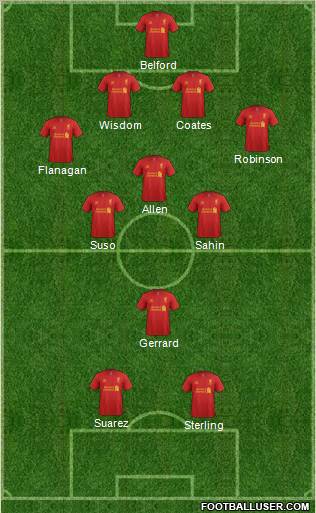
The stand-out example has to be Raheem Sterling, a 17-year-old who barely looks older than 15, but who has shown the skill and maturity of a much more experienced player, even making it as far as the senior England squad. However it’s in the lesser competitions that Anfield’s stars of the future have really begun to shine, capped by the League Cup debut of Jerome Sinclair – at an astonishing 16 years and 6 days old, LFC’s youngest ever player.
We have been watching teenagers who are likely to grace Liverpool team sheets for many years to come, such as Andre Wisdom, Suso, Jack Robinson, Samed Yesil, Adam Morgan, Jon Flanagan and the aforementioned Sinclair. Others such as Stephen Sama and Conor Coady have made the first team bench and their debuts seem to be just around the corner.
But why now? And why are these youngsters having such an impact?
I loved Rafa as a manager, but I was often disappointed that the exciting youngsters I saw playing for the reserves in online videos failed to ever appear in the first team. When he did play some lesser-known players in a cup competition, he suffered the club’s heaviest home defeat in over 75 years. His Liverpool team that lost 6-3 to Arsenal at Anfield in the 2007 League Cup featured relatively unknown youngsters such as Danny Guthrie, Lee Peltier and Gabriel Paletta (although the latter pair had already turned 20). I remember thinking at the time that Benitez was right to field a weakened team for a season that ultimately ended with another Champions League final, but a look at the list of substitutes (Reina, Carragher, Alonso, Garcia, Crouch) paints a very different picture from Brendan Rodgers’ selections in Switzerland or at The Hawthorns.
Similarly, Roy Hodgson was roundly criticized by fans and journalists alike when he put out a severely weakened side and lost League Cup tie in a penalty shoot-out against Northampton Town in September 2010. Danny Wilson, Martin Kelly, Dani Pacheco, Jay Spearing and David Ngog were all around 20 years old at the time, while the bench was warmed by Wisdom, Hansen, Eccleston, Ince, Amoo, Shelvey and Robinson, of whom only the last two had seen previous first-team action.
As for Kenny Dalglish, the enduring legacy of his second spell in the Anfield hot-seat will be his overspending on high-profile players that didn’t live up to expectations, rather than handing a debut to Raheem Sterling.
Of course it doesn’t take much mental effort to think of the other major example of where faith in youth has paid dividends besides at Old Trafford and The Emirates/Highbury. It’s at the Nou Camp. Here’s where Rodgers is fortunate, because it was Rafael Benitez who brought Rodolfo Borrell and Pep Segura to Anfield from Barcelona, where they had guided the nascent careers of players like Messi, Iniesta, Piqué, Fabregas and Krkic. Their work with the LFC Under-18s and Academy is now producing extremely positive results. Although Borrell has been promoted to manager of the Under-21s and Segura left Liverpool last week, current Academy director Frank McParland revealed his high hopes for the current crop in a recent Guardian interview.
Benitez’s raid on the Barça backroom is finally bearing fruit on the field due to Rodgers’ well-documented preference for the Spanish high-pressing, tiki-taka style of football. He has inherited a bunch of teenagers who have been schooled in the same system by Segura and Borrell for the last three years, and anyone who has watched the exciting performances of Sterling, Wisdom and Suso in recent matches can see the difference between their style and that of established internationals such as Carroll, Downing, and the now-departed Adam. It appears that the more experienced players (with the exception, in my opinion, of Gerrard, Johnson, Suarez and Agger) are having more trouble adjusting than the “kids”, with Rodgers fast losing patience with Downing and Enrique in particular.
This weekend Rodgers named Liverpool’s youngest EPL starting XI since the 2003-04 season and it paid dividends with an emphatic 5-2 victory over Norwich. LFC’s last three away matches have heavily featured teenage players and yet (or because of this) have produced an astonishing 12 goals. The club clearly has a policy of investing in youth, with McParland stating that the goal is to eventually have a first team consisting of 50 percent Academy products. Given the fact that Assaidi, Borini, Coates, Shelvey, Kelly, Henderson and Allen are also under 25 years old, there is plenty of reason to optimistic for the near and long-term future of the club. As far as this writer is concerned, the kids are alright.

No comments:
Post a Comment